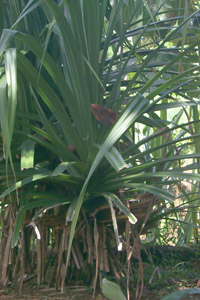 Subscribe to my feed for ingredients
Subscribe to my feed for ingredients  Add to My Yahoo
Add to My Yahoo 
© Copyright 1995-2023, Clay Irving <clay@panix.com>, Manhattan Beach, CA USA
 Subscribe to my feed for ingredients
Subscribe to my feed for ingredients  Add to My Yahoo
Add to My Yahoo
Pandanus Leaf Characteristics
Pandanus leaf, also known as screwpine leaves, bai toey in Thailand, la dua in Vietnam, rampe in Sri Lanka, and duan pandan in Mayaysia and Indonesia, is used throughout Southeast Asia in cooking to impart a rich green color and soothing distintive flavor. Pandanus leaves are also used to weave mats, hats, fans, baskets, and roofs! It has been reported that dried pandanus leaves mixed in water and fermented for a while makes a good hair conditioner!
In Thailand, one of the most common uses for pandanus leaves in cooking is Kai Haw Bai Toey (fried chicken wrapped in pandanus leaf). The leaves are also used to prepare sweets like Thua Paeb Bai Toey (pandanus balls with mung bean filling). This dessert is based on a mixture of sticky rice flour and fresh shredded coconut. The dough balls are formed using the green-tinged water obtained by boiling pandanus leaves, which impart a subtle and indefinable fragrance. After cooking the dough, the balls are stuffed with a mixture of soaked and steamed mung beans, roasted sesame seeds and sugar. A surprisingly tasty mouthful as one bites through the ball of coconut and flour and reaches the total contrast of the filling.
Varieties
There are several of the Pandanaceae family that grow in tropic regions. The most famous are the pandanus odoratissimus (a tree with spiral blade leaves, with aerial roots and a white male flower that is also known for itís voluptuous flavor) and the pandanus odorus (known as daun pandan).
 |
 |